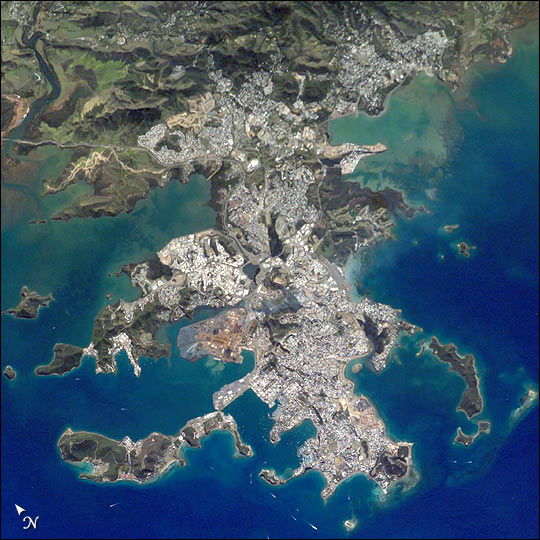


New Caledonia represents a nexus of cultures and resources. At its center is Grande Terre, the third largest island in the Pacific. The indigenous population is Melanesian, with a Polynesian minority, but New Caledonia remains a French territory. A prime tourist destination, the island supports the second largest barrier reef in the world (over 1300 km long) with one of the highest levels of biodiversity. See a Space Shuttle photograph of northern Grande Terre.
The mountains forming the spine of the island of Grande Terre contain large reserves of nickel and chromium, and New Caledonia mines are one of the world’s greatest producers of nickel. The combination of natural resources provides unique opportunities for understanding the impact of heavy development. Open mining activity leads to sedimentation in streams and estuaries as well as high concentrations of transition metals (chromium and nickel)—all of which can affect the health of reefs and reef organisms.
This image shows details of New Caledonia’s main city, Noumea, which is built on a peninsula that juts into the lagoon on the southwest side of the island. The reefs here face localized problems from pollution and overfishing. The tourism industry is very important to the economy of Noumea, with extensive hotel development in the city and along the southeast coast of Grand Terre. The picture shows how urban development extends to the steep slopes of the coastal hills.
Astronaut photograph ISS007-E-14867.was taken September 13, 2003 with a Kodak DCS760 digital camera equipped with an 400mm lens and provided by Cynthia A. Evans (Lockheed Martin / Earth Observations Laboratory, Johnson Space Center). The International Space Station Program supports the laboratory to help astronauts take pictures of Earth that will be of the greatest value to scientists and the public, and to make those images freely available on the Internet. Additional images taken by astronauts and cosmonauts can be viewed at the NASA/JSC Gateway to Astronaut Photography of Earth.